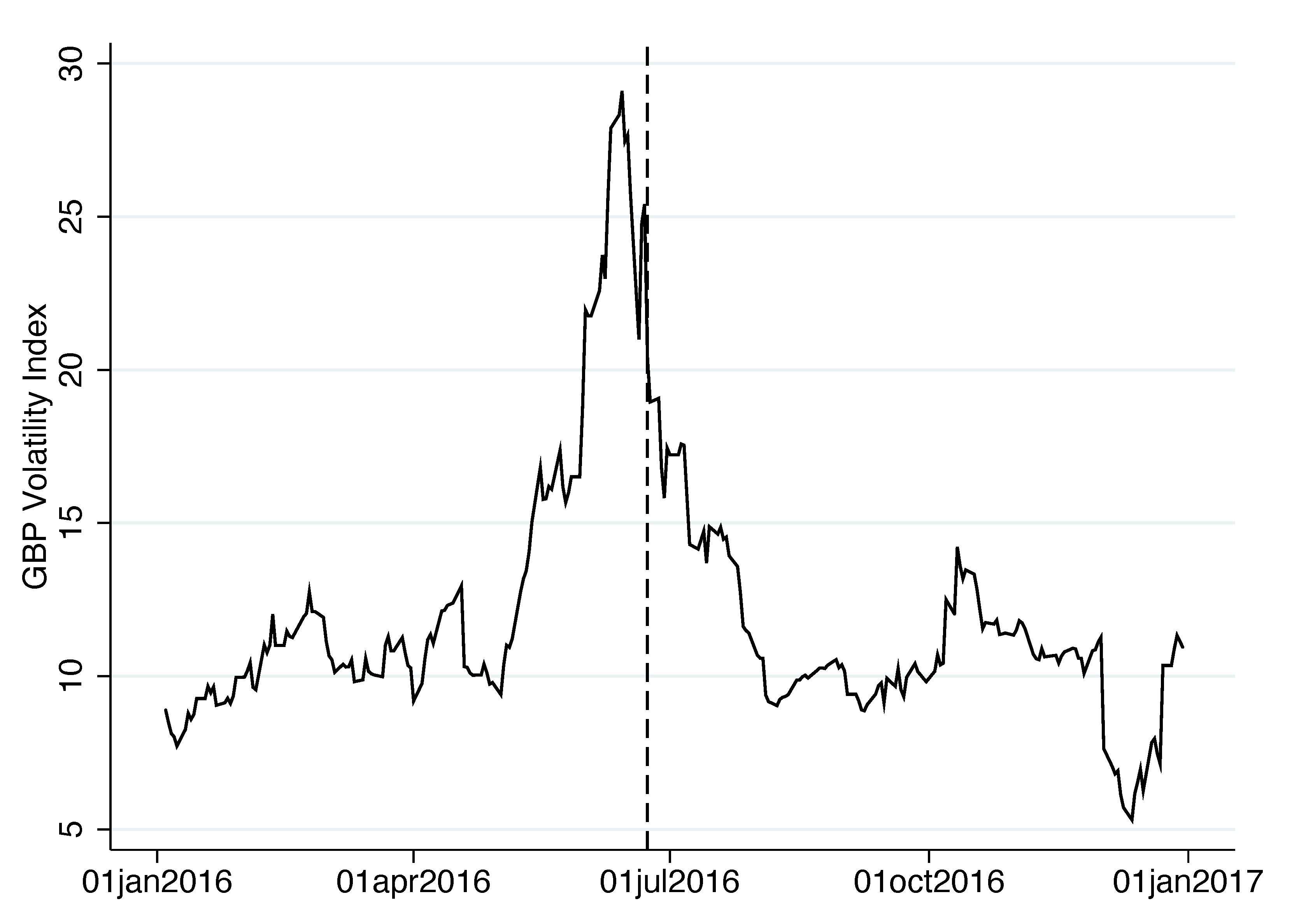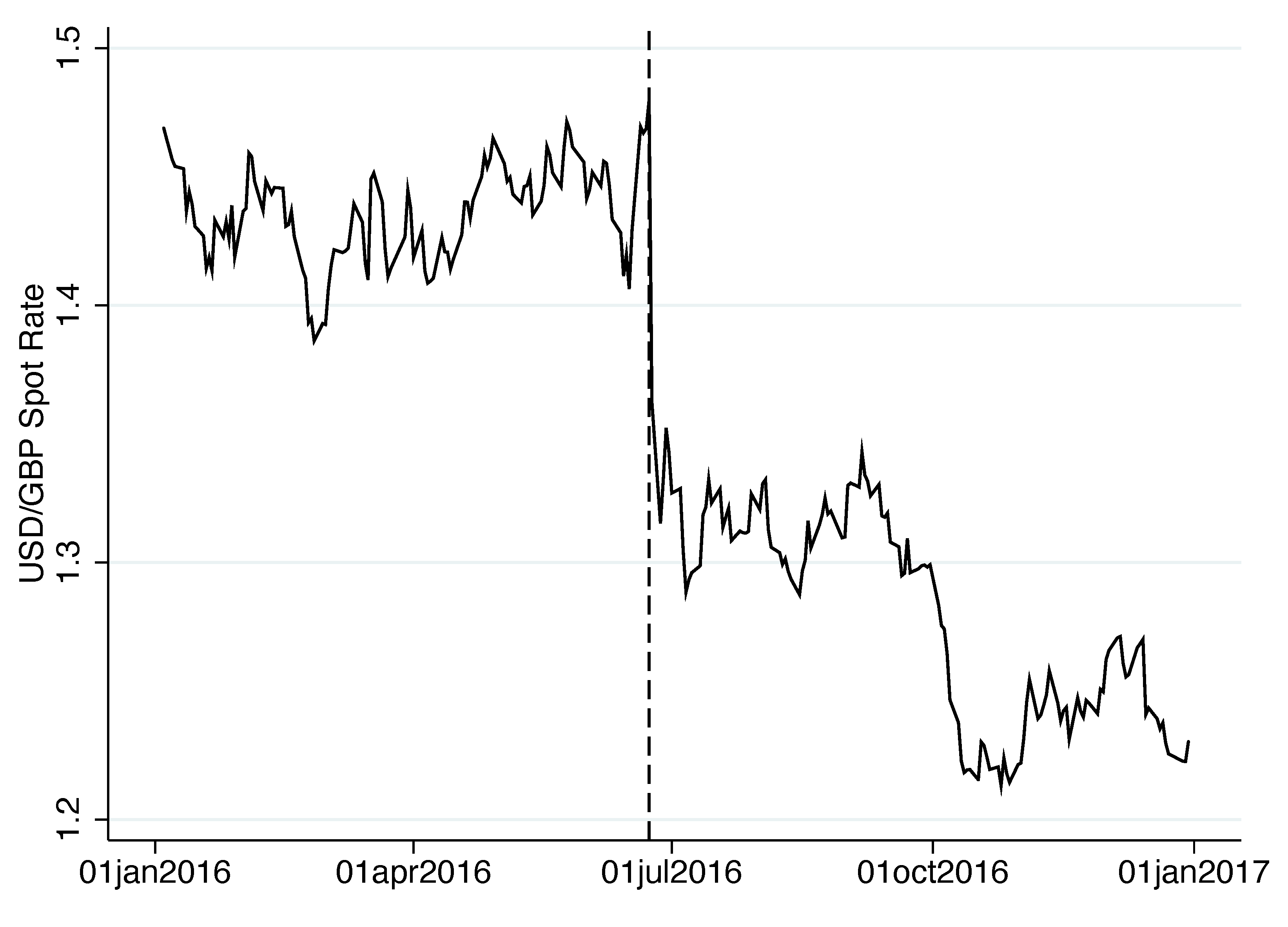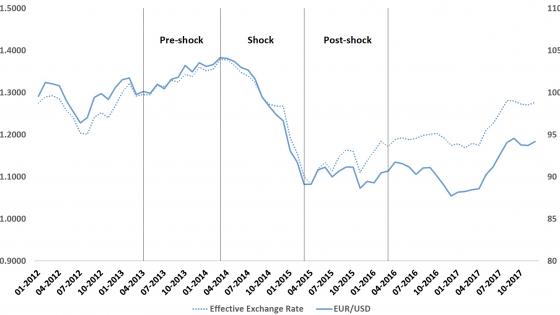The deepening of economic globalisation through international trade and finance is one of the major macroeconomic developments of the past decades (e.g. Krugman 1995, Bordo et al. 2003). Banks play a special role in this regard. In their function as financial intermediaries and central dealers, they provide essential foreign exchange services to firms that are active in international product and factor markets and wish to manage inherent cross-currency cash flows (e.g. Ethier 1973, Duffie 2010). However, when banks supply foreign exchange credit and derivatives to firms, they build up foreign exchange positions. If those positions are not balanced across banks’ different assets and liabilities, this leads to currency mismatches and related exposure to exchange rate risk in the banking system (e.g. Gabaix and Maggiori 2015). In the past, these concerns have been predominantly raised and studied in the context of emerging markets and their exchange rate policies (e.g. Calvo and Reinhart 2002, Chang and Velasco 2006, Acharya et al. 2015, Burger et al. 2018, Forni and Turner 2021).
Not only a matter of concern for emerging markets
In a recent study (Abbassi and Bräuning 2022), we use granular microdata on banks’ on- and off-balance-sheetforeign currency positions in Germany to shed light on the role of banks’ unbalanced foreign currency positions for the transmission of exchange rate shocks to the real economy in developed countries. Importantly, even if banks’ net foreign currency exposure is zero in the aggregate, we show that heterogeneity across banks’ net currency exposure can lead to sizeable adverse effects in response to an exchange rate shock.
We infer our insights from an analysis that exploits the period leading up to and immediately following the UK’s referendum to leave the EU (‘Brexit’ referendum hereafter) in 2016. The period between the announcement of the referendum on 22 February 2016 and the actual referendum on 23 June 2016, is characterised by increasing uncertainty about the post-referendum value of the pound sterling. The outcome of the referendum itself caused the pound to depreciate 12% against the euro and similarly against all other major currencies (Figure 1).
Figure 1 Pound pre-Brexit uncertainty and post-Brexit devaluation
a) Exchange Rate Volatility Index
b) Spot exchange rate
Notes: Panel (a) shows the Cboe/CME FX pound 30-day Volatility Index, which measures the market’s expectation of future (30-day) currency-related volatility. Panel (b) shows the US dollar/pound spot exchange rate. The vertical dashed line indicates the Brexit referendum date of 23 June 2016.
Source: Bloomberg and own calculations.
In response to the elevated exchange rate uncertainty prior to the referendum, we find that (nonbank) firms increased their use of GBP derivatives (measured by the gross notional value of GBP forward contracts) with German banks by about 23% on average. Due to the structural cross-industry variation in net exports to the UK, there is important cross-industry heterogeneity in firms’ net short exposures (that is, the difference between short and long positions) to the post-Brexit pound value.
Banks, as central counterparties to these derivatives transactions, increased their supply of pound forwards in the period before the referendum date, but also with sizable and growing heterogeneity in their net GBP derivatives position, suggesting that some banks did not fully intermediate the migrated risk (Figure 2, Panel a). In fact, about 20% of the banks had accumulated a derivatives exposure of at least 15% of their equity value before the referendum date. Importantly, we show that a bank’s net GBP derivatives exposure at the referendum date is closely linked to skewed client demand stemming from (ex-ante) industry concentration among its derivatives clients. For example, banks that supplied derivatives to industries with an increased demand for net short positions in the run-up to the referendum tended to have a net long exposure just before the Brexit referendum. The tight link between industry concentration and net derivatives exposure holds after we account for banks’ on-balance-sheet net GBP assets, which could potentially offset the risks from a non-zero GBP derivatives exposure (Figure 2, Panel b).
Figure 2 Banks’ pound derivatives exposure and post-Brexit losses
a) Net pound derivatives exposure prior to the Brexit referendum
b) Ex-ante industry exposure and post-Brexit pound losses
Note: Panel a) shows the cross-sectional distribution of banks' cumulative net long GBP derivatives positions with maturity dates after the Brexit referendum of June 23, 2016. Net refers to the difference between exposure from long GBP derivatives positions and short GBP derivatives positions. The vertical line indicates the Brexit referendum on 23 June 2016. Long-dashed lines refer to the 5th and 95th percentiles, dashed lines to the 10th and 90th percentiles, and dotted lines to the 25th and 75th percentiles. The data points for 2016m6 include only contracts initiated before the Brexit referendum. Panel b) shows a bin scatter of post-Brexit total GBP losses against exposure to net-long industries measured during a pre-sample period.
After the referendum, i.e., when the pound’s value plummeted about 12% relative to the euro, banks with a total (net) long GBP exposure faced substantial losses. Using the marked-to-market valuation of individual forward contracts and on-balance-sheet exposure, we show that for 10% of banks, the total loss was larger than 13% of their equity value. These GBP total losses, in turn, affected banks’ credit supply: banks that experienced large losses from their net GBP total exposure (and thus an adverse shock to their net worth) differentially cut back credit to firms. Our baseline estimate indicates an average elasticity of -0.73, suggesting that for a one percentage point GBP total loss, a bank cuts back credit supply by 73 basis points, on average – with substantially stronger effects for banks with a lower equity-to-assets ratio, consistent with the notion that capital constraints are binding.
The identified post-Brexit credit-supply contraction induced by banks’ GBP losses had aggregate effects on firms’ funding conditions and real economic activity. In particular, our firm-level analysis shows that firms with a strong dependence on banks that suffered GBP losses also experienced an overall cutback in credit after the referendum (Figure 3). That is, affected firms were not able to substitute the loss of funding by increasing borrowing from other banks, which is consistent with previous evidence on the lack of substitutability of bank credit relationships, which may be rooted in asymmetric information problems (e.g. Petersen and Rajan 1995).
Figure 3 Credit growth depending on lending bank’s GBP losses
Note: The figure shows the unconditional mean credit growth (in percent) at the firm level for firms with and without ex-ante loans from GBP-loss banks. The vertical dashed line indicates 2016:Q2, when the Brexit referendum happened. Both series are normalised to take the value of 0 in 2016:Q2 and are basked on a constant sample of firms that we observe in each quarter.
Source: Supervisory transaction-level derivatives available under European Market Infrastructure Regulation (EMIR), banks’ external positions (AUSTA), balance sheet statistics (BISTA), German credit register, and own calculations.
Importantly, we show that firms exposed to banks facing a loss as a result of the GBP depreciation account for 76% of total lending in Germany. The same firms account for 67% of total capital (fixed assets) and 79% of total assets in the German real economy. Thus, our result on the overall credit contraction for affected firms is about 32% stronger than the average credit contraction after the Brexit referendum and is also present for nonfinancial firms. Moreover, we show that firms without any GBP derivatives usage – those that likely did not have any exposure to foreign exchange risk – experienced a credit reduction from banks facing derivatives losses. Finally, we trace the transmission to real activity by showing that German nonfinancial firms with strong ex-ante credit relationships with banks facing GBP losses reduced investment about 2 percentage points more than firms without ties to those banks, thereby strongly contributing to the overall decline in aggregate private investment in Germany in the aftermath of the referendum. We also find that, consistent with credit market frictions, the adverse effects on credit and investment are concentrated in small firms.
Major takeaways
These results have important implications for macroeconomic and financial models that focus on the transmission of exchange rate shocks to the economy. In particular, they highlight that balance sheet effects of exchange rate shocks can not only be transmitted through firms that have exchange rate exposure through international product or factor markets, but also through banks with unbalanced net total currency positions. These currency mismatches have the potential to significantly amplify shocks of systemic scope, which, if ignored in international macroeconomic models, could lead to incomplete views of the adverse effects of exchange rate movements.
Our results also provide several insights for policymakers. First, and most directly, when designing regulatory foreign exchange risk charges for banks, regulators may want to take into account the financial stability effects of total currency mismatches and their associated adverse effects on banks’ credit supply. Importantly, while exchange rate risk has typically been discussed in the context of emerging markets, our findings suggest that such risks are also a serious concern for financial stability in developed-market countries as long as currency mismatches prevail at banks in those countries. This is particularly important as exchange rates may move rapidly in response to changes in macroeconomic conditions and financial risks. Second, and more broadly, while we do not address normative questions in this paper, our findings suggest that discussions about the optimal reallocation of foreign exchange risk in the economy (i.e. efficient risk allocation) should include banks and their special role in shock propagation. Third, our insights also are relevant for the conduct of monetary policy, which needs to consider an economy’s balance sheets effects through foreign exchange exposure.
References
Abbassi, P and F Bräuning (2022), “Exchange Rate Risk, Banks' Currency Mismatches, and Credit Supply”, conditionally accepted for publication at the Journal of International Economics.
Acharya, V, S Cecchetti, J D Gregorio, S Kalemli-Ozcan, P Lane, U Panizza (2015), “Emerging economy corporate debt: The threat to financial stability”, VoxEU.org, 5 October.
Bordo, M D, A M Taylor and J G Williamson (2003), Globalisation in Historical Perspective, University of Chicago Press.
Burger, J D, F Warnock, V C Warnock (2018), “Re-emerging currency mismatches”, VoxEU.org, 19 September.
Calvo, G A and C M Reinhart (2002), “Fear of floating”, The Quarterly Journal of Economics 117(2): 379–408.
Chang, R and A Velasco (2006), “Currency mismatches and monetary policy: A tale of two equilibria”, Journal of International Economics 69(1): 150–175.
Duffie, D (2010), “The Failure Mechanics of Dealer Banks”, Journal of Economic Perspectives 24(1): 51–72.
Ethier, W (1973), “International Trade and the Forward Exchange Market”, The American Economic Review 36(3): 494–503.
Forni, L and P Turner (2021), “Global liquidity and dollar debts of emerging market corporates”, VoxEU.org, 15 January.
Gabaix, X and M Maggiori (2015), “International Liquidity and Exchange Rate Dynamics”, The Quarterly Journal of Economics 130(3): 1369–1420.
Krugman, P (1995), “Growing World Trade: Causes and Consequences”, Brookings Papers on Economic Activity 26(1, 25th Anniversary Issue): 327–377.








